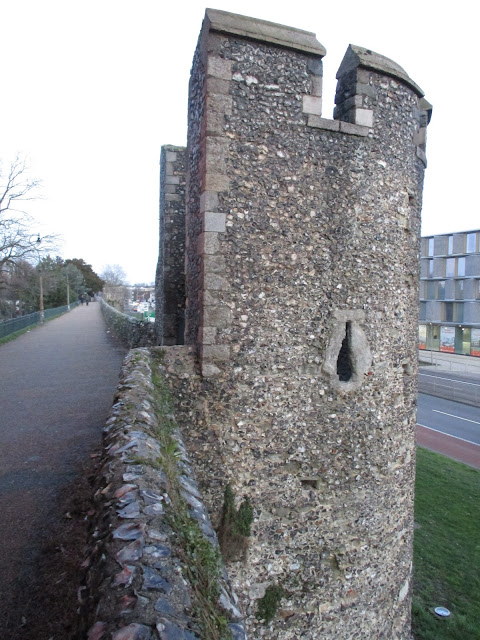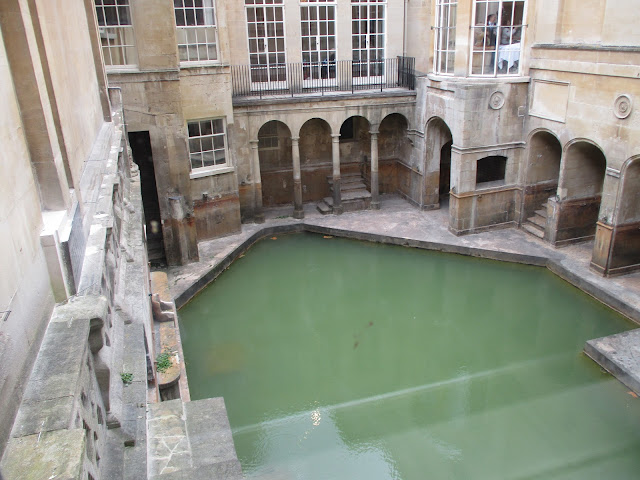Roman Britain
 |
| Remnants of the Londinium Wall |
History within Britain wouldn't have been recorded until the arrival of the Romans who established the country as 'Britain'. They invaded the lands and established many settlements (many of which are still towns and cities to this day): London, Bath, Cirencester, Exeter and Canterbury just to name a few. In fact, the word 'cester, chester or caster' comes from the Latin 'castrum' meaning 'fort', so the cities that bear these endings are undoubtedly Roman.
The Romans introduced so many new concepts to the Britons, who fought valiantly against them; such as the written word, roadway and sewer systems, building structures and trading routes with other Roman-run countries. Today, there are so still many ruins and artifacts of British Roman occupation from 2000 years ago still standing to this day, and I was fortunate enough to be able to see many of them.
You can view a dated timeline of Roman occupation from Historic UK's site; as well as, exhibits and studies regarding the Roman cemeteries and remains found throughout the country (at the time of my visit in 2019, the Museum of Liverpool had some Roman 'mummies' on display). Romans were known to bury their dead far from the city walls and limits for sanitary and religious reasons.
Londinium
While Colchester was Britain very first and oldest 'city', Londinium gained in power and popularity for its access to the Thames, which was a major trading route. During Roman occupation of a couple centuries, Londinium became home to many structures and the famous London Wall that surrounded the settlement.
Large segments of the wall can still be seen throughout Central London, and you can partake in a self-guided walking tour to see the wall that stretches around the Museum of London, all the way to the Tower.
Museum of London
The Museum of London provides a historic tour of the city throughout the millennia, beginning with the Mesolithic time period. I really love this museum and greatly enjoy each of the exhibits; they're sectioned off by time period. The coolest part of the museum is seeing the London Wall below you:
London Mithraeum
Hidden underneath an office building is the Roman remains of a small temple built to worship the god of war, Mithras. As protection and defence was a man's responsibility, it was only men who worshipped Mithras in secret. The temple itself was dark and windowless, to protect worshippers from onlookers.
Within the small museum, there is also a wall of Roman artifacts that were discovered to give you a glimpse of life during the time of Londinium. Amongst these finds are some well-preserved wooden and leather pieces (organic materials that would have easily decomposed over the millennia).
Visits to the Mithraeum are free, but should be booked in advance.
Other Roman Walls
Other cities I was able to visit with intact Roman walls were Canterbury and Exeter.
Roman Exeter
The Romans established Isca Dumnoniorum, and a wall was built around the city for military protection. Over the centuries, the wall was demolished in order to expand the city and sections of it can be seen around the central part of town. Preservation efforts were used to keep the wall standing, but through the use of other building materials.
Interestingly, back in September 2019, a Roman fort was discovered underneath the bus station in the centre of town. More information about it can be found here.
Roman Canterbury
Known as Durovernum Cantiacorum, the town of Canterbury's Wall is a more complete example of Roman construction and defence. The town has done well in preserving this Roman construction, and has converted part of it into a walking path - so yes, you can literally walk on a 2000-year old structure!
There is also a Roman Museum within the city, which was once a Roman townhouse, 8-feet below modern ground level. It contains many models, actual artifacts and information about Roman life.
Roman Baths
It goes without saying that the city of Bath has one of the most famous and exceptional Roman structures in the country: the Roman Baths. In the 1800s, the land above the ruins were townhouse lots and it wasn't until the basements of one of these homes began to flood with water did they discover what was beneath.
The building's ceiling and top-half were gone over time, but the original floors and structure remained intact. The city rebuilt the bath house to restore its aesthetic. The original source natural hot spring water still runs within the building.
You are able to walk throughout the entire structure from the changing rooms, to the sauna and the main bathing area. The saunas were built over a suspended floor so that hot air flowed into the room.
Servants would have massaged your body with oil, then you'd go into the sauna to sweat and open your pores. Your skin would be scraped and the dirt and dead skin would be deposited into pots and you could go into the baths to relax and exchange gossip. However, if you were a gladiator, your dead skin would have been collected and made into a face cream for women (as it was considered an aphrodisiac).
People would have also prayed to Sulis Minerva about a crime committed against them using curse tablets (inscriptions were cast on small pieces of pewter or lead and thrown into the baths). Essentially, they would pray that the wrongdoer would get their just deserts.
Packed with 43 minerals, the natural spring water can even be drunk at this site! Of course, you cannot touch or drink the flowing spring, but take it from a filtration system built in the wall. The water tasted slightly metallic and sweet (some people were not a fan).















Comments
Post a Comment